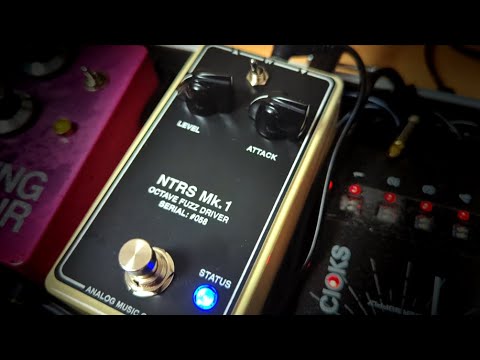NOTORIOUS RABBIT OCTAVE FUZZ
Highly articulate and detailed. Pure analog. That's not fuzz - that's worship at full volume - evil, wicked, mean and nasty! You either love it or hate it. The Notorious Rabbit is a compact analog octave fuzz driver based on a nonlinear gain architecture and passive filtering. It is designed to operate with high sensitivity to source conditions, exploiting instability and saturation behavior as primary elements of its response.
The input signal passes through a selectable filter network that defines the frequency content presented to the gain stage. This stage is based on a Darlington configuration using both silicon and new old stock germanium transistors, resulting in a non-linear and dynamically reactive amplification characteristic.
EXPLORING THE NOTORIOUS RABBIT & ITS FEATURES
OVERVIEW AND OPERATION:
The Notorious Rabbit is a compact analog octave fuzz based on a nonlinear gain architecture and passive filtering. It is designed to operate with high sensitivity to source conditions, exploiting instability and saturation behavior as primary elements of its response.
The input signal passes through a selectable filter network that defines the frequency content presented to the gain stage. This stage is based on a Darlington configuration using both silicon and germanium transistors, resulting in a non-linear and dynamically reactive amplification characteristic.
Before entering the main amplifier, the signal is subjected to diode-based clamping that limits the differential voltage and shapes the waveform. This contributes to early saturation and introduces asymmetry in the signal response.
The conditioned signal is then amplified, with the final stage providing additional gain and low output impedance. The circuit as a whole exhibits strong sensitivity to the input signal level and source impedance. Under higher input levels, the interaction between the clamping, transistor behavior, and amplifier gain can result in complex, unstable, collapsing, or gated waveforms, giving the Notorious Rabbit its distinctly synthetic waveform quality and characteristic sonic and dynamic behavior.
CONTROLS:
- Attack: Sets the amount of signal driven into the transistor stage. Higher settings increase gain and saturation, resulting in more aggressive and unstable behavior. Lower settings produce a softer response and greater dynamic control. This control strongly influences gating, collapse characteristics, and harmonic content.
- Voice: A two-position toggle switch that selects between two input filter configurations. Each position alters the frequency spectrum entering the gain stage, affecting the texture and response of the fuzz. One position emphasizes midrange content, while the other allows more low frequencies to pass through.
- Level: Adjusts the overall output volume of the effect. This control does not affect the internal gain structure or clipping behavior, only the final output amplitude.
TECHNICAL DATA:
- Input impedance: Approximately 1MΩ.
- Power requirements: 9V DC centre-negative power supply.
- Signal chain placement: Notorious Rabbit is designed to interact directly with passive pickups or unbuffered signal sources. Placing it after a buffer, preamp, or active pedal may alter its intended response or reduce dynamic behavior. For best results, we recommend using it as the first device in the signal chain.
USAGE NOTES:
- Pickup sensitivity: The Notorious Rabbit responds differently depending on the output level and impedance of the source. High-output pickups, especially humbuckers, can push the circuit into extreme saturation when the Attack control is set high. This may result in unstable or gated behavior, which is a normal and intentional aspect of the design.
- Playing dynamics: The circuit is highly reactive to pick attack. Heavier playing can provoke more pronounced instability, gating, or collapsing textures. Softer touch results in smoother transitions and more controlled behavior, making the pedal responsive to performance dynamics in a way that rewards expressive playing.
- Gain control interaction: Reducing the Attack control can tame aggressive or collapsing textures and yield a more stable fuzz response. Similarly, adjusting the guitar’s volume knob can significantly shape the pedal’s behavior. Small changes in input level have a noticeable effect on sustain, gating, and harmonic emphasis.
- Recommended practice: Start with Attack at minimum and Level at unity gain. Gradually increase Attack until the desired level of harmonic saturation and texture is achieved. Use the guitar’s volume control and pick dynamics for additional expression and fine-tuning during performance.
Due to the circuit’s sensitivity to both signal amplitude and impedance, each instrument will produce a unique tonal response when interacting with the Notorious Rabbit.
NOTORIOUS RABBIT DEMO BY AMBIENT TRASH
NOTORIOUS RABBIT DEMO BY RJ RONQUILLO
NOTORIOUS RABBIT DEMO BY JAY LEONARD J
NOTORIOUS RABBIT DEMO BY MIKE HERMANS
NOTORIOUS RABBIT DEMO BY 32RIFFS
NOTORIOUS RABBIT DEMO BY PEDALS AND TEA
NOTORIOUS RABBIT DEMO BY PEDAL OF THE DAY
WHERE TO GET THE NOTORIOUS RABBIT
The Notorious Rabbit is currently available for purchase only directly from the AMCO store with worldwide shipping.
Downloads
NOTORIOUS RABBIT MANUAL






